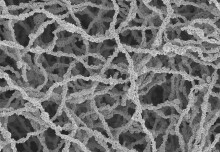
High Five: Globally unique material sectioning, processing, analysis and 3D reconstruction

The Department of Materials was awarded an EPSRC Strategic Equipment grant for a globally unique surface analysis facility called High Five
The Department of Materials has been awarded an EPSRC Strategic Equipment grant for a brand new, globally unique surface analysis facility called High Five that will be operational in 2018. The Principal Investigator for this project is Dr Ainara Aguadero, Departmental Lecturer and PDRA Champion, who is leading a research group focusing on energy conversion and storage devices (solid oxide, electrolysers and solid state lithium batteries) in the Electro-ceramics Group with Professors John Kilner and Stephen Skinner. Co-investigators are based mainly in London at UCL and KCL with the instrument located in a purpose-built laboratory for the Surface Analysis Facility where the UHV time-of-flight secondary ion mass spectrometer (SIMS) and combined low energy scattering (LEIS) instruments are managed by Dr Sarah Fearn.
High Five adopts its name from the 5 qualities that characterise it: Resolution, Sensitivity, in operando Control, Ultra High Vacuum and Ion Sectioning in a single instrument. The instrument will be a novel high performance dual secondary ion mass spectrometer (SIMS) for innovative 3D chemical and microstructural analysis combined with in-operando processing. Nano-scale lateral resolution, material sectioning, lithography and sputtering for SIMS analysis are all possible using a single unique gas ion plasma source and column that is under development for this bespoke configuration. The Department’s collaborators in this enterprise are Hiden Analytical of Warrington, UK and Oregon-Physics of Seattle, USA.
The impact of High Five reflects the widespread interests of the co-investigators in the Project covering widely spread areas of materials characterization and development for energy conversion and storage (IC & UCL), aerospace and nuclear advanced alloys (IC & KCL), information storage and micro-electronics (UCL) and healthcare technologies (IC, KCL & QUB). In healthcare, for example, this instrument will be applied to the role of chemical deposits and bio-mineralization on a number of degenerative diseases such as age-related macular degeneration, atherosclerosis, aortic valve stenosis, cancer and Alzheimer’s disease. This new, ~£2.2M, research grant award for a high performance SIMS instrument is the fifth in a succession begun almost 30 years back in 1979 by Professor Brian Steele during his leadership of the Wolfson Unit for Solid State Ionics in the Department of Materials. Professor John Kilner and Dr Richard Chater began the focus on the SIMS technique with tracer oxygen-18 techniques for oxygen diffusion and exchange measurements on solid oxide materials and are both involved in the new High Five project today.
(This article is printed with design illustration from the CAD work by Hiden Analytical and Oregon-Physics focused on ensuring that all the components of High Five are correctly orientated in their UHV environment of the main analysis chamber.)
Supporters

Article text (excluding photos or graphics) © Imperial College London.
Photos and graphics subject to third party copyright used with permission or © Imperial College London.
Reporter
Caroline Detchenique
Department of Materials

Contact details
Email: press.office@imperial.ac.uk
Show all stories by this author



